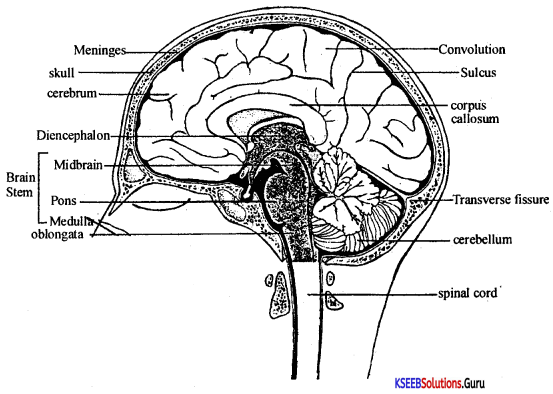Students can Download 1st PUC Biology Previous Year Question Paper March 2017 (South), Karnataka 1st PUC Biology Model Question Papers with Answers helps you to revise the complete Karnataka State Board Syllabus and score more marks in your examinations.
Karnataka 1st PUC Biology Previous Year Question Paper March 2017 (South)
Time: 3.15 Hours
Max Marks: 70
General Instructions:
- The question paper consists of four parts A, B, C, and D.
- All the parts are compulsory.
- Draw diagrams wherever necessary. Unlabelled diagrams or illustrations do not attract any marks.
Part – A
Answer the following questions in one word / one sentence each: ( 10 × 1 = 10 )
Question 1.
What is parthenocarpic fruit?
Answer:
If the fruit is formed without fertilization of the ovary.
Question 2.
Define Staminode.
Answer:
A sterile stamen is known as a staminode.
Question 3.
Earthworms are known as friends of farmers. Why?
Answer:
Because they make burrows in the soil and make it porous which helps in respiration and penetration of the developing plant roots.
Question 4.
Name the powerhouses of the cell.
Answer:
Mitochondria.
![]()
Question 5.
Define Osmosis.
Answer:
Osmosis can be defined as the diffusion of water across a semi-permeable membrane.
Question 6.
What is Leg-haemoglobin?
Answer:
Leg-haemoglobin is a pink-colored pigment present in the root nodule and acts as an oxygen scavenger.
Question 7.
Name the gaseous plant growth regulator.
Answer:
Ethylene.
Question 8.
What is plasticity?
Answer:
Plants follow different pathways in response to the environment or phases of life to form different kinds of structures. This is known as plasticity.
Question 9.
Expand ECG
Answer:
Electrocardiograph.
Question 10.
Name the region of the vertebrate eye where the optic nerve passes out of the retina.
Answer:
Blindspot.
PART-B
Answer any FIVE of the following questions in 3-5 sentences each, wherever applicable. (5 × 2 = 10)
Question 11.
Name the algal and’ fungal compnent of Lichens.
Answer:
The algal component is phycobiont and the fungal component is mycobiont.
![]()
Question 12.
Mention four major groups of protozoans.
Answer:
Four groups of protozoans are:
(a) Flagellated protozoans.
(b) Ciliated protozoans.
(c) Amoeboid protozoans.
(d) Sporozoan protozoans.
Question 13.
Write any two general characters of phylum Ctenophora.
Answer:
(a) Ctenophores are exclusively marine, radially symmetrical, diploblastic organisms with tissue level of organization.
(b) Bioluminescence (emit light) is well marked in ctenophores.
Question 14.
What are macronutrients? Mention any two of them.
Answer:
Nutrients required in large amounts (in excess of 10 m mole kg-1 dry weight of the plant body are known as macronutrients, eg: carbon and nitrogen
Question 15.
Define
(a) Ammonification
(b) Hydroponics.
Answer:
(a) Decomposition of organic nitrogen of dead plants and animals into ammonia.
(b) Technique of growing plants in a nutrient solution.
Question 16.
List any two physiological effects of Auxins.
Answer:
(a) Auxins help to initiate rooting in stem cuttings.
(b) Auxins promote flowering eg: in pineapples.
Question 17.
Write the differences between Systole and Diastole.
Answer:
Systole is the contracted state of the chambers of the heart.
Diastole is the relaxed state of the chambers of the heart.
![]()
Question 18.
Name the antigens and antibodies present in the A and B blood groups.
Answer:

PART-C
Answer any FIVE of the following questions in 40 to 80 words each, wherever applicable. (5 × 3 = 15)
Question 19.
List and explain any two taxonomical aids.
Answer:
(a) Herbarium: It is a storehouse of collected plant specimens that are dried, pressed, and preserved on sheets. Further, these sheets are arranged according to a universally accepted system of classification.
(b) Botanical gardens: These specialized gardens have collections of living plants for reference.
Question 20.
Explain three types of Phyllotaxy.
Answer:
(a) Alternate phyllotaxy: a single leaf arises at each node, eg: china rose.
(b) Opposite Phyllotaxy: a pair of leaves arise at each node and lie opposite to each other eg: Calotropis.
(c) Whorled phyllotaxy: More than two leaves arise at a node and form a whorl, eg: Alstonia.
Question 21.
List any three types of chromosomes based on the position of the centromere.
Answer:
(a) Metacentric chromosome: chromosome with middle centromere forming two equal arms.
(b) Sub-metacentric: chromosome has centromere slightly away from the middle of the chromosome resulting in one shorter arm and one long arm.
(c) Acrocentric: centromere is situated close to its end forming one extremely short and one very long arm.
(d) Telocentric: chromosome has a terminal centromere.
![]()
Question 22.
Classify the plastids ba&d on the type of pigments.
Answer:
- Chloroplasts: contain more chlorophylls and few carotenoids.
- Chromoplasts: contain carotenoids.
- Leucoplast: colorless plastids with stored nutrients.
Question 23.
Name any three significances of Mitosis.
Answer:
Significance of Mitosis:
- The somatic chromosome number (2n) in all the cells of an organism is effectively maintained by mitosis. The duplication of chromosomes occurs during interphase and their orderly behavior during the different stages of mitosis maintains a constant chromosome number.
- The daughter cells produced as a result of mitosis are quantitatively and qualitatively identical.
- Mitosis of somatic cells helps in the growth and development of multicellular organisms.
- It forms a means of multiplication in some of the over organisms eg: Amoeba, Eugene, etc.
- Mitosis produces new cells for the healing of wounds and for regeneration.
Question 24.
Mention three steps in Urine formation.
Answer:
(a) Ultrafiltration
(b) reabsorption
(c) tubular secretion.
Question 25.
Write a note on Actin.
Answer:
Actin (Thin) filament: length is about 1.0 nm and breadth 9 nm globules
- Actin filament contains three proteins namely actin (F-actins and G-acts), tropomyosin, and troponin.
- Each actin filament consists of two F (filamentous)-actins, that are helically wound to each other.
- Each F-actin is a polymer of G-globular actins.
- Two filaments of tropomyosin also run close to the F-actins throughout their length.
- Troponin is a complex protein found at regular intervals on the tropomyosin.
- In the resting state, a subunit of troponin masks the actin-binding site of myosin.

Question 26.
Name three types of joints.
Answer:
(a) Fibcousjoint
(b) Cartilagenous joint
(c) Synovial joint
PART-D (Section – I)
I. Answer any FOUR of the following questions in 200-250 words each, wherever applicable. (4 × 5 = 20)
Question 27.
List any five general characteristics of Gymnosperms.
Answer:
1. The life cycle has a distinct, dominant, diploid, asexual phase represented by the well-differentiated evergreen woody plant, which is known as the sporophyte.
2. The sporophyte is heterosporous bearing microspores and megaspores within microsporangia and megasporangia respectively. These structures occur on leaf-like microsporophylls and megasporophylls. These are further organized into fertile structures called strobila or cones.
3. Sporophyte shows the presence of a taproot system which is well developed. The stem possesses branches that are dichotomies. Leaves are well developed and are dimorphic (two types of leaves): viz,
- Green photosynthetic leaves (Foliage).
- Brown-colored scale leaves.
4. Microspore develops into male gametophyte and megaspore produces female gametophyte. The gametophytes represent the haploid phase and are highly inconspicuous in comparison with sporophytic generation.
5. Female gametophyte is enclosed within a megasporangium that in turn is covered by an integument. Such an integuments megasporangium possessing the female gametophyte is called the ovule.
![]()
Question 28.
Write any four general characteristics of class Mammalia. Mention an oviparous Mammal.
Answer:
(a) Class Mammalia:
1. Class Mammalia includes warm-blooded and highly organized animals possessing mammary (milk) glands for suckling their young ones. They live almost in all the environments of the world and undergo secondary adaptation to suit their habitats. They are also known as hair quadrupeds.
2. Mammals are all homoeothermic (warm-blooded) animals.
3. The body shape varies, and it is covered by hairs.
4. Body is divisible into the head, neck, trunk, and tail.
5. Skin is glandular and includes sebaceous, and sweat glands in both the sexes and mammary glands in the females.
6. Head region possesses a pair of eyes protected by eyelids and eyelashes, a pair of external ears or pinnae, and a pair of external nares.
7. They possess two pairs of pentadactyl legs, which are variously modified to perform different functions [like walking, running, climbing, swimming, burrowing, and lying. Digits bear horny claws, nails, or hoofs.
8. Teeth are placed in sockets [ThecodontJ. Teeth are heterodont [different types of teeth
i.e, all are not of the same morphology], and diphyodont [i.e. 2 sets of teeth milk teeth
and permanent teeth].
9. There is well-developed voice apparatus, the larynx.
10. m is a muscular diaphragm separating the thorax and abdomen.
11. Respiration is by lungs.
12. Circulatory syštem consists of a four-chambered head ‘which maintains complete double circulation. RBC‘s are non-nucleated.
13. Nervous system is well developed. The brain consists of a large cerebrum, cerebellum, and cerebral cortex. There are 12 pairs of cranial nerves.
14. Excretory organs comprise a pair of metanephric bean-shaped kidneys and a coronary bladder. Nitrogenous water products are excreted in the form of urea (present in urine fluid).
15. Sexes are separate, and sexual dimorphism is seen.
16. Fertilization is internal.
17. MajorIty are viviparous. Viviparity is common except in the egg-laying mammal called platypus.
eg: Lion, Tiger, Cat, Dog.
(b) Platypus.
Question 29.
(a) List any two differences between springwood and autumn wood,
Answer:
| Springwood [Earlywood] | Autumn wood [late wood] |
| (a) Secondary xylem formed during the spring season is called springwood | (a) Secondary xylem formed during the autumn season is called autumn wood. |
| (b) Xylem vessels are thin-walled with a wide lumen | (b) Xylem vessels are thick-walled with narrow lumen |
(b) Differentiate Heartwood from the sapwood.
Answer:
| Heartwood (Duramen) | Sapwood (Alburnum) |
| 1. It is a central dark-colored nonfunctional part of the secondary xylem of an old stem | 1. It is the outer, light-colored functional part of the secondary xylem of an old stem. |
| 2. Tracheary elements are plugged by tyloses or get filled with resin gum or tannins. | 2. Tracheary elements are not plugged. |
| 3. It is heavier and more durable | 3. It is lighter less durable. |
| 4. It is less susceptible to the attack of pathogens and insects | 4.It is more susceptible to the attack of pathogens and insects. |
Question 30.
Draw a neat labeled diagram of an Animal cell.
Answer:
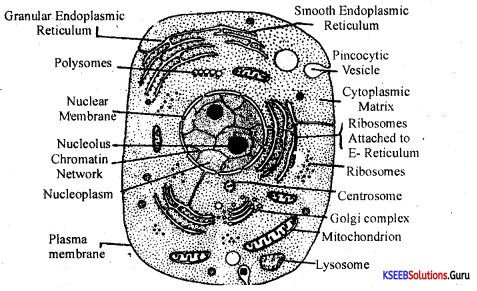
Animal Cell – Ultrastructure
![]()
Question 31.
Write the schematic representation of glycolysis.
Answer:
- It occurs in the cytoplasm of the cell.
- It is an enzymatic reaction, thus temperature sensitive.
- It is a common reaction for both aerobic and anaerobic respiration.
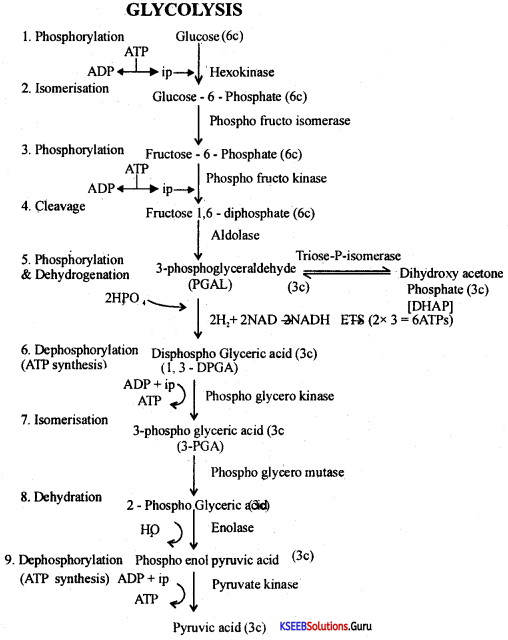
Question 32.
List the hormones secreted by the following glands.
1. Thyroid
2. Adrenal
3. Ovary
4. Testis
5. Pancreas.
Answer:
(a) Thyroid – Thyroxine, Tri-iodo thyronine
(b) Adrenal-Adrenaline, epinephrine
(c) Ovary – estrogen, progesterone
(d) Testis – Testosterone
(e) Pancreas – Insulin, Glucagons
Section – II
II. Answer any THREE of the following questions in 200-250 words each, wherever applicable. (3 × 5 = 15)
Question 33.
(a) Name three types of cell junctions.
(b) Mention any two specialized connective tissues.
Answer:
(a) Tight junction, adhering junction, and gap junction.
(b) Cartilage, Blood, Bones (any two).
Question 34.
Classify the enzymes based on the type of reaction they catalyze.
Answer:
- Oxidoreductases: Act on many chemical groupings to add or remove hydrogen atoms.
- Transferases: Transfer functional groups between donor and acceptor molecules. Kinases are specialized transferases that regulate metabolism by transferring phosphate from ATP to other molecules.
- Hydrolases: Add water across a bond, hydrolyzing it.
- Lyases: Add water, ammonia, or carbon dioxide across double bonds, or remove these elements to produce double bonds.
- Isorne rases: Carry out many kinds of isomerization: L to D isomerizations. Mutase reactions (shifts of chemical groups) and others.
- Ligases: Catalyze reactions in which two chemical groups are joined (or ligated) with the use of energy from ATP.
Question 35.
Describe pressure flow or mass flow Hypothesis.
Answer:
According to Munch, food materials are translocated from the source (leaves) to sink (roots) enmass, through a turgor pressure gradient that occurs between leaves and roots.
The mechanism of translocation can be explained as follows:
1. Sugars are formed in the mesophyll cells during photosynthesis and are loaded into the phloem sieve elements of veins. This is called vein loading.
2. The osmotic potential in the phloem becomes more negative, and as a result, water is drawn into phloem elements from xylem cells.
3. Turgor pressure increases in the sieve tubes of leaves, and at the same time the turgor. the pressure of roots becomes less. So a turgor pressures gradient occurs between mesophyll cells and root cells.
4. As a result, food molecules in solution form, are translocated from leaves to roots.
5. In the roots the food is consumed, and in the fruits, it is converted into insoluble starch. So osmotic potential and turgor pressure in the roots and storage organs decreases.
6. Thus turgor pressure gradient continues between leaves, and roots and translocation of food also continue.
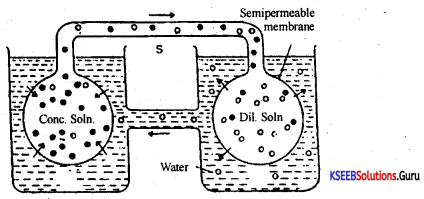
Munch conducted a physical experiment to demonstrate the mass flow. He took two osmometers A and B, with concentrated sugar solution in A and B filled with a dilute solution. These are connected by a ‘U’ tube C. A B is immersed in a trough containing water.
Now water enters into ‘A’, due to high osmotic pressure and this creates turgor pressure. This results in mass flow of sugar solution from A to B through ‘C’ until equilibrium is attained and maintained. He compared osmometer A to leaves, B to roots, C to phloem, and water in vessels to xylem vessels. This clearly explains the mass flow hypothesis.
![]()
Question 36.
Explain the Z-scheme of light reaction.
Answer:
Non-cyclic photophosphorylation is also called ‘Z’ scheme electron transport.
In this cycle, the electrons lost by chlorophyll pigment do not return to the same molecule.
Both PS I and PS II are utilized.
One molecule of ATP is formed.
Two molecules of NADPH2 are formed.
One molecule of O2 is formed.
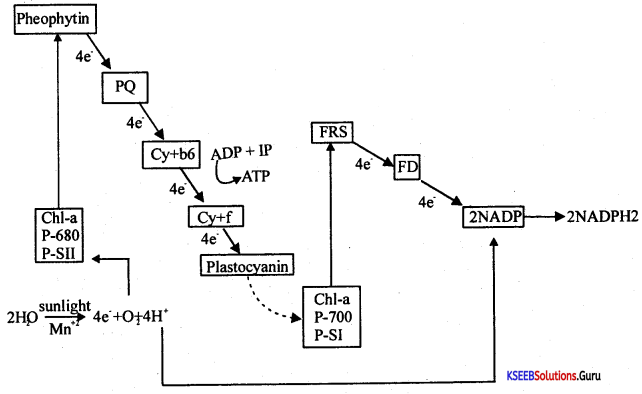
Question 37.
Draw a neat labeled diagram showing a sagittal section of the Human brain.
Answer:
